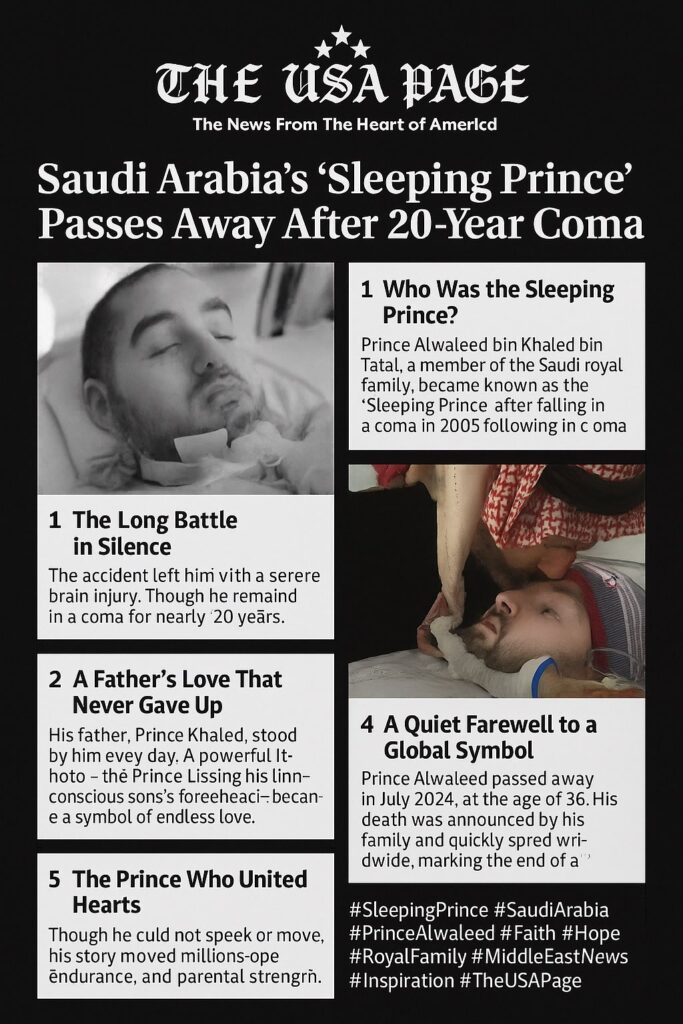The world recently witnessed the end of one of the most touching stories of modern times when Prince Al-Waleed bin Khaled bin Talal Al Saud, widely known as the sleeping At the age of 36, the prince passed away on July 19, 2025. This remarkable story of the sleeping prince of saudi arabia captured hearts across the globe, showcasing an extraordinary journey of faith, family devotion, and unwavering hope that lasted for nearly two decades. The saudi prince al waleed became a symbol of perseverance, while his father’s dedication to his son’s care transformed their story into a testament of paternal love that moved an entire nation.

The Royal Heritage Behind the Sleeping Prince
Prince Al-Waleed bin Khaled bin Talal Al Saud, who would later achieve global fame, was born in April 1990 into one of the most esteemed royal families of Saudi Arabia. As the eldest son of Prince Khaled bin Talal Al Saud and nephew of billionaire businessman saudi prince al waleed bin talal, the young prince carried a distinguished lineage within the House of Saud. His great-grandfather was King Abdulaziz, the founder of modern Saudi Arabia, making him part of the core royal bloodline that has shaped the kingdom for generations. The al waleed bin khaled bin talal name represented not just royal heritage but also the promise of a bright future that would tragically be interrupted.
The Tragic Accident That Changed Everything

The story of how a promising young prince became the saudi arabia sleeping prince began with a devastating car accident in London in 2005. At just 15 years old, Prince Al-Waleed was studying as a military cadet at a London academy, preparing for what many expected would be a distinguished career in service to his country. The incident took place during his military education in the United Kingdom, which is a typical endeavor for Saudi royals aiming for international exposure and training. The vehicle collision resulted in the young prince with severe brain injuries, including massive brain hemorrhaging and internal bleeding. These catastrophic injuries resulted in immediate emergency surgery, but the trauma to his brain was so extensive that he fell into a deep coma from which he would never recover. The accident transformed the vibrant, promising teenager into the figure who would become known as the saudi prince al waleed sleeping prince, lying motionless in a hospital bed for the next 20 years.
Two Decades at King Abdulaziz Medical City
After the incident, Prince Al-Waleed was flown back to Saudi Arabia and admitted to King Abdulaziz Medical City in Riyadh, which is recognized as one of the most sophisticated medical institutions in the Middle East. This state-of-the-art hospital, established in 1983, serves as a comprehensive medical center with over 2,500 inpatient beds and cutting-edge facilities. The medical city became the sleeping prince’s home for the next two decades, where he remained on life support under constant medical supervision. The hospital’s medical teams, along with specialists from the United States and Spain, worked tirelessly to provide the best possible care for the prince. Despite their expertise and the most advanced medical technology available, Prince Al-Waleed never regained consciousness beyond occasional involuntary movements that briefly raised hopes among his family and followers. The King Abdulaziz Medical City became not just a place of medical treatment but a sanctuary where faith, hope, and medical science intersected in an extraordinary story of human endurance.
A Father’s Unwavering Faith and Devotion
Perhaps the most remarkable aspect of the sleeping prince’s story was the unwavering dedication of his father, Prince Khaled bin Talal Al Saud. For 20 years, Prince Khaled refused all medical advice to discontinue life support, maintaining an unshakeable belief that divine intervention could heal his son. His famous words, “If God had wanted him to die in the accident, he would have been in his grave now,” became a defining statement of faith that resonated throughout the Arab world. Throughout the years, Prince Khaled regularly shared updates on social media, particularly on X (formerly Twitter), where he posted prayers, hospital visits, and moments of hope. During Islamic holy periods like Ramadan and Eid, he would decorate his son’s hospital room and conduct prayers, turning the medical facility into a place of spiritual significance. These social media posts often went viral, with millions following the journey of the sleeping prince and his devoted father.
The Global Impact and Social Media Phenomenon
The story of the sleeping prince transcended royal circles and became a global phenomenon, particularly on social media platforms. Videos showing the prince’s occasional finger movements or subtle responses to Quranic recitations generated millions of views and sparked widespread hope among followers. The hashtag #SleepingPrince became a regular trending topic, especially during significant dates like the prince’s birthday on April 18. However, the story also attracted misinformation, with false videos claiming the prince had awakened circulating widely online. One notable instance in 2025 involved a video of Saudi businessman Yazeed Mohamed Al-Rajhi that was incorrectly presented as showing the sleeping prince’s recovery. These incidents highlighted the global attention and emotional investment people had in the sleeping prince’s story.
The Medical Reality Behind the 20-Year Coma
From a medical perspective, Prince Al-Waleed’s condition represented one of the longest documented cases of persistent vegetative state following traumatic brain injury. The initial car accident caused what medical experts describe as catastrophic brain hemorrhaging, leading to irreversible neurological damage. Despite interventions by international medical teams and cutting-edge treatment protocols, the prince remained in a minimally conscious state throughout his 20-year ordeal. Medical experts explained that the occasional movements observed in the prince were likely involuntary reflexes rather than signs of consciousness. The case became a study in the intersection of medical science, family devotion, and spiritual faith, as the family’s decision to maintain life support for two decades challenged conventional medical recommendations while inspiring millions with their unwavering hope.
The Final Chapter: July 2025
On July 19, 2025, the long vigil finally came to an end when Prince Al-Waleed passed away at the age of 36. His father announced the death in a deeply emotional post on X, quoting verses from the Quran and expressing both profound grief and acceptance of divine will. The announcement read: “With hearts full of faith in Allah’s decree and destiny, and with profound sadness and sorrow, we mourn our beloved son Prince Al-Waleed bin Khaled bin Today, Talal bin Abdulaziz Al Saud, may Allah have mercy on him, has transitioned to the mercy of Allah. The news of his passing triggered an immediate outpouring of condolences from across Saudi Arabia and the broader Arab world. The Global Imams Council issued an official statement praising the patience and steadfastness demonstrated by Prince Khaled and his family throughout their ordeal.
The Funeral and Final Farewell
Funeral prayers for the sleeping prince were held on July 20, 2025, at the Imam Turki bin Abdullah Mosque in Riyadh following the Asr prayer. Separate arrangements were made for women, with prayers conducted at King Faisal Specialist Hospital after the Dhuhr prayer. The funeral arrangements reflected Islamic traditions while accommodating the significant public interest in paying respects to the royal family.
Condolence gatherings were scheduled for three days, from July 20 to July 22, 2025, at the family’s Al-Fakhriyah palace. The extended mourning period allowed the Saudi people and international visitors to express their sympathies to a family that had touched so many lives through their public journey of faith and endurance.
The Legacy of Love and Faith
The story of Saudi Arabia’s sleeping prince extends far beyond the tragic circumstances of his condition. It developed into a strong narrative regarding the intensity of parental love, the power of faith, and the ability to foster hope when faced with challenges that seem insurmountable. Prince Khaled’s refusal to give up on his son, despite decades of medical uncertainty, inspired countless families facing similar challenges around the world. The sleeping prince’s hospital room at King Abdulaziz Medical City became an informal shrine where visitors from across the Arab world would come to pray and seek inspiration. Religious leaders, government officials, and ordinary citizens alike found meaning in the story of a father’s devotion and a family’s unwavering faith in divine providence.
Frequently Asked Questions About the Sleeping Prince
Q: Who was the sleeping prince of Saudi Arabia?
A: The sleeping prince was Prince Al-Waleed bin Khaled bin Talal Al Saud, eldest son of Prince Khaled bin Talal and nephew of billionaire Prince Al-Waleed bin Talal. He earned this nickname after spending 20 years in a coma following a 2005 car accident.
Q: What factors contributed to the sleeping prince falling into a coma?
A: In 2005, at age 15, Prince Al-Waleed suffered severe brain injuries and internal bleeding in a car accident while studying at a military academy in London.
Q: Why did his father refuse to end life support?
A: Prince Khaled bin Talal maintained unwavering faith that God could heal his son, famously stating, “If God had wanted him to die in the accident, he would have been in his grave now”.
Q: Did the sleeping prince ever show signs of recovery?
A: Occasionally, Prince Al-Waleed showed involuntary movements like finger twitches or head movements, which gave hope to his family but were medically considered reflexive rather than conscious responses.
Q: Where was the sleeping prince treated?
A: He received care at King Abdulaziz Medical City in Riyadh, one of Saudi Arabia’s most advanced medical facilities, for the entire 20-year period.
Q: When and how did the sleeping prince die?
A: Prince Al-Waleed passed away on July 19, 2025, at age 36, after 20 years in a coma. His father communicated the news of the death via social media.
Read more article please click on the Link.